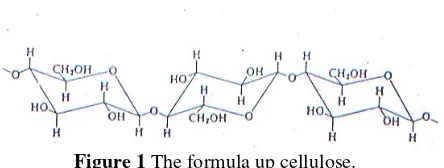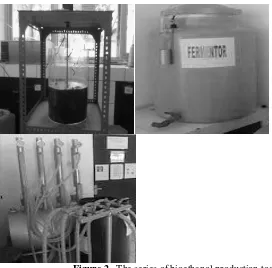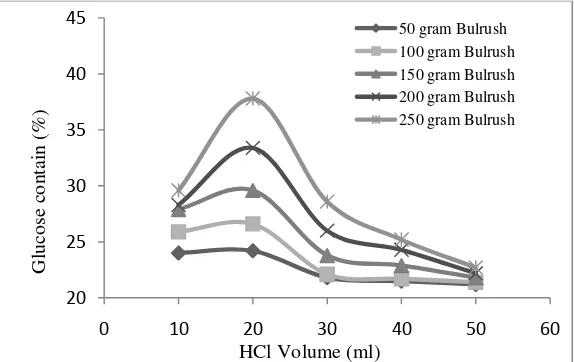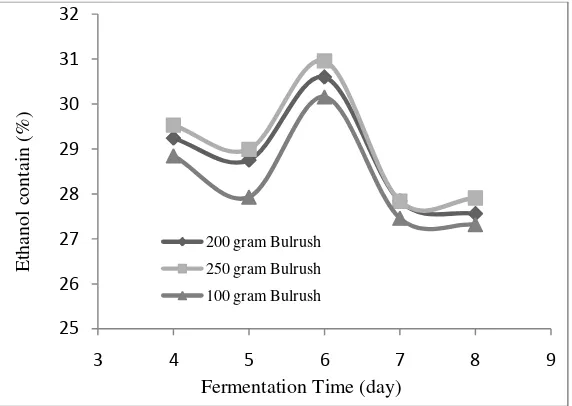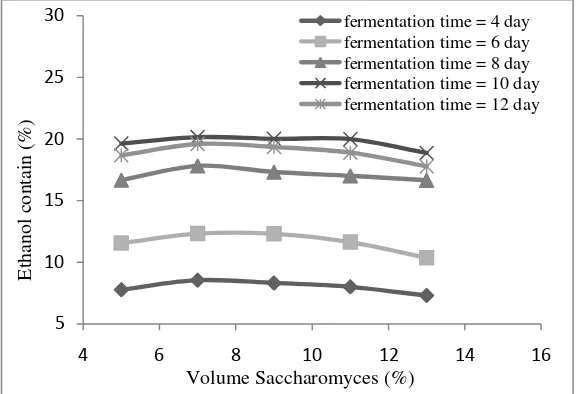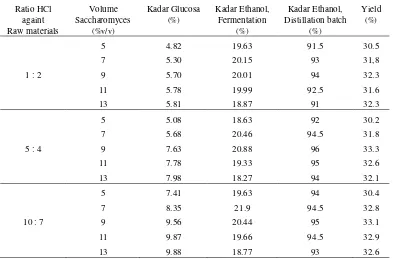Bioethanol Production Comparison of Elephant Grass and
Liquid Waste Plant Wheat Boga Sari
Ni Ketut Sari1, C. Pujiastuti2, I Nyoman Abdi3
1,2
Department of Chemical Engineering UPN “Veteran” East Java, Surabaya 60295 Indonesia
3
Bali State Polytechnic, Bali 80364 Indonesia
E-mail: sari_ketut@yahoo.com
Abstract. The availability of elephant grass and liquid waste plant wheat Boga Sari can be maintained continuous and also available in huge volume. It is raw material which is less attention, after raw material analysis, has cellulose, glucose, and starch contain, where both the raw materials have potential as bioethanol. This study has the objective to produce bioethanol and bioethanol as well as an industrial prototype as a reference in developing bioethanol industry in Indonesia. Bioethanol production process includes raw material hydrolysis with HCl, reducing sugar fermentation by bacteria of Saccharomyces Cerevisiae, and batch distillation process. Ethanol quality is affected by cellulose, starch, glucose in raw material. With the comparison obtained can be used as a basis for the design of a prototype bioethanol production processes and equipment. Raw materials to produce bio-ethanol showed that the levels of (95-96) % with a yield (31.69 - 33.3) %, by knowing process comparison, in order to obtain scale distillation column design mini plant with 100 liter scale ethanol/day in 3 batches. Raw materials economically liquid waste plant wheat Boga Sari catering is more profitable than raw materials elephant grass.
Keywords: batch distillation; elephant grass; fermentation; hydrolysis; whaet plant liquid waste.
1
Introduction
Leri water is rice water obtained in the processing of rice flour from rice, which has rice water still not fully utilized, only limited to watering plants, livestock drink or thrown away. Judging from the content of nutrients and starch content of the water leri still likely to be further processed, is one of the alternative processing into ethanol. Ethanol is made by the fermentation of yeast ingredients with rice water hydrolysis process is done in advance, long fermentation depends on the type of yeast used, initial glucose levels and the desired levels of ethanol. Very abundant availability of raw material and can be obtained continuously enabling can be used to produce ethanol continuously anyway. Waste washing rice has the carbohydrate content of 300 mg/liter at rice 2 kg, with the carbohydrate content is allowed to be used as a feedstock for ethanol production. Rice water has not been fully utilized and can interfere with the environment if left alone. Indonesia has several places producing rice water like in a restaurant, rice flour mill waste and households, with the potential of certain sources of raw material for making glucose will be available in large enough quantities [8].
Ethanol is used in diverse industries such as mixed for sake or liquor like gin, pharmaceutical and cosmetic raw materials, and the mix of vehicle fuel, octane enhancer, ethanol gasoline (gasohol) and as a source of oxygen for a cleaner burning replacement (methyl tertiary-butyl ether/MTBE). Because ethanol contains 35 percent oxygen, can increase the efficiency of combustion. Ethanol is also environmentally friendly because of the low gas emission levels monoksidanya carbon, nitrogen oxides, and greenhouse gases are a pollutant and readily biodegradable and safe because it does not pollute the environment. Until now consume about 63 percent of world ethanol for fuel, especially in Brazil, North America, Canada, the European Union, and Australia. In Asia, Japan and South Korea are the biggest consumption of ethanol is for booze. Pemerintan program in 2025 about the use of ethanol as a fuel, ethanol production only depends on the raw material is waste molasses sugar mills, sugar mills presence in Indonesia is not growing. Drops produced does not meet the quantity, so it is necessary the development of alternative raw materials for ethanol products.
2 Review of Literature
2.1 Quality Raw Materials
Bulrush in general is an annual plant that stands erect, rooted in, high rhizome. High stems can reach 2-4 meters (even reaching 6-7 meters), with a trunk diameter can reach more than 3 cm and comprises up to 20 segments / book. Growing up with a clump forming clumps up to 1 meter wide. Leaf midrib glabrous to short-hairy, leaves striped with a wide base, pointed tip. Nutrient content per ton of dry matter is: N: 10-30 kg, P: 2-3 kg; K: 30 kg; Ca: 3-6 kg, Mg and S: 2-3 kg [15]. Other content of elephant grass are: 5.2% crude protein and crude fiber 40.85%. Cellulose is a glucose polymer-bonded β-1, 4 units between glucose. Cellulose serves as a structural material in plant tissue in the form of a mixture of polymer homologues and is usually accompanied by other polosakarida and lignin in various quantities. Elongated and rigid cellulose molecules, although in solution. Hydroxyl groups protruding from the chain can form hydrogen bonds with ease, resulting in kekristalan within certain limits. A high degree of kekristalan cause greatly increased elasticity modulus and tensile strength of cellulose fibers become bigger and result in food that contain more clay cellulose. Cellulose is a polysaccharide that is the highest on earth can be converted to glucose by acid hydrolysis.
Figure 1 The formula up cellulose.
Table 1 Leri water nutritional value.
Carbohydrates are the main source of calories for humans than protein and fat. Carbohydrates have the empirical formula (CH2O)n also has an important role in determining the characteristics of foods, such as flavor, color, texture, and others. Carbohydrates are useful for preventing excessive body protein breakdown, loss of minerals and useful to help metabolize fats and proteins. In nature, carbohydrates formed from the reaction of CO2 and H2O with the help of sunlight through the process of photosynthesis in plant cells that chlorophyll, while the ingredients that are a source of carbohydrates obtained from the roots and stems of plants such as corn, grass, bagasse [7]. Carbohydrate is the staple food in many Indonesia parts are grains, especially rice and corn.
In general, carbohydrates can be grouped into three sections: monosaccharides, is a molecule that consists of 5 or 6 C atoms, containing one aldehide group called aldose, while ketosa have a ketone group, monosaccharides with 6 carbon atoms called hexoses, such as glucose (dextrose / grape sugar), while having 5 C atoms are called pentoses, eg xylose, arabinose and ribose. Oligosaccharides, are polymers of monosaccharides 2-10, are usually soluble in water, oligosaccharides consisting of 2 monosaccharide molecules called disaccharides, is an example of the disaccharide sucrose, oligosaccharides can be obtained from the hydrolysis of polysaccharides with the help of enzymes or acid hydrolysis. Polysaccharide, composed by many monosaccharide molecules, the food texture serves as a reinforcing material (cellulose, hemicellulose, pectin and lignin) and as a source of energy (starch, glycogen, fructan) [10].
2.2 Hydrolysis Process
into ethanol by acid hydrolysis process to some degree. Cellulose hydrolysis process must be carried out with concentrated acid to produce glucose [3]. Hydrolysis process is influenced by several factors, including: pH affects the hydrolysis process so that it can be produced hydrolysis as expected, a good pH for hydrolysis was 4.5 [9]. Temperature also affects the speed of the hydrolysis reaction, good temperature for hydrolysis of cellulose is about 21OC. Concentrated HCl or H2SO4 concentration affects the rate of reaction of concentrated acid hydrolysis. In the process of hydrolysis, the cellulose in the grass is converted into glucose by the reaction:
(C6H10O5)n + n H2O nC6H12O6 (1) Cellulose Glucosa
Starch is a component that is more complex than a disaccharide, before fermentation, starch must be broken by using the enzyme amylase into the disaccharide maltose component. By using enzymes, maltase and maltose would hydrolysis to glucose [12].
(2)
(3)
Hydrolysis process is influenced by several factors, including the amount of carbohydrate in raw materials, operating pH or the concentration of the acid used, hydrolysis time, hydrolysis temperature and catalyst.
2.3
Fermentation Process
The fermentation process is carried out is the fermentation process that does not use oxygen or anaerobic processes. To control the production of ethanol from sugar is quite complex, the concentration of substrate, oxygen, and ethanol products, all cerevises Saccharomyces affecting metabolism, cell survival, cell growth, cell division, and ethanol production. Saccharomyces cerevices suitable selection and have a high tolerance for both concentrations, alcohol substrate is important for improving yields [1]. Fermentation was the first time the basic treatment of the seed fermentor or starter preparation. Where the starter inoculated until completely incorporated into the fermenter ready, put in new substrate to be fermented [2].
Seed fermentor used was Saccharomyces cerevisiae. The fermentation process is influenced by the process of fermentation, mikoroorganisme really need good
(C6H10O5)n + 1/2n H2O 1/2n C12H22O11
Enzyme Amilase
1/2n C6H12O6
1/2n C12H22O11 + 1/2n H2O
nutrition in order to obtain a good fermentation. Proper nutrition is to supply nitrogen microorganisms which can be obtained from the addition of NH3, ammonium salts, peptone, amino acids and urea. Nitrogen is needed for liquid L gram/1000 400-1000. Phosphate is needed for 400 gram/1000 L fluid [9]. Other nutrients are ammonium sulfate with gram/100 70-400 liters of fluid levels [5]. Good pH for bacterial growth is 4.5 to 5. But at pH 3.5, fermentation can still run well and spoilage bacteria inhibited, can be used to adjust the pH of NaOH and HNO3. A good temperature for bacterial growth is between 20-30 oC. The lower the fermentation temperature, the higher the ethanol that will be produced, because at low temperatures will be more complete fermentation and ethanol loss carried away by the CO2 gas will be less. The time needed for fermentation was 7 days [5]. The sugar content will be very menpengaruhi fermentation process, given optimum sugar content for fermentation is 25%, for starters, the sugar used is 16% [10]. Volume a good starter for fermentation is 1/10 part of the substrate volume. In the fermentation process, fermentation of glucose is converted into ethanol by the following reaction:
Sacc. Cere. composition of the vapor component i (yi).
Where, = dimensionless number that depends on time, so obtained equation is substituted:
The above equation is a model Differential-Algebraic-Equations (DAEs) for simple batch distillation of multi-component systems, assuming no phase forming two liquida. The above equation is the forward-finite-difference, will be obtained in the bottom liquida composition (xi,j+1) as a function of , thus obtained as follows [6]:
xi,j+1 = xi,j + (yi,j– xi,j) (10)
Where the composition of the early liquida at bot (xi,j) dan determined, while the composition of the vapor (yi,j) is calculated using equation BUBL T [4].
3 Research Methods
Based on Figure 3 above bioethanol production to produce bioethanol needs to assess the quality of some of the parameters that influence such as: the degree of acidity (pH), the volume ratio of HCl to the elephant grass and the volume of wastewater that is used, the added volume cereviceae Saccaromyces, long fermentation time is required, long time batch distillation is required. Analysis of the quality of raw materials and products of bioethanol done with laboratory analysis, the analysis was conducted on the instrumentation and gravimetric analysis. Instrumentation for analysis using Gas Chromatography (GC) and Spectrophotometer, include: starch, glucose, ethanol concentration, HCl concentration, levels of crude protein and the remaining N, P, K, Ca, Mg, S. For gravimetric analysis include: pH, temperature and volume of raw materials.
Figure 2 The series of bioethanol production tools
Analysis of the concentration (cellulose, starch, glucose), and then enter the elephant grass and liquid waste (according to treatment) into the stirred tank reactor with a certain volume. Enter HCl solution with a certain concentration and did the stirring speed 200 rpm, the stirring is done in a certain time, separate the solids formed from the mother liquor. Wash the solids with water, wash water ratio / certain solids, separate the solids from the liquid, the dry solids at a given temperature and time, concentration analysis of cellulose, starch, glucose and HCl.
4
Results and Discussion
4.1
Quality Raw Materials
Carbohydrates have the empirical formula (CH2O)n also has an important role in determining the characteristics of foods, such as flavor, color, texture, and others. Carbohydrates are useful for preventing excessive body protein breakdown, loss of minerals and useful to help metabolize fats and proteins. In nature, carbohydrates formed from the reaction of CO2 and H2O with the help of sunlight through the process of photosynthesis in plant cells that chlorophyll, while the ingredients that are a source of carbohydrates obtained from the roots and stems of plants such as sago [7]. Carbohydrate is the staple food in many Indonesia parts are grains, especially rice and maize.
4.1.1 Quality Elephant Grass
The results of laboratory analysis, it is known that the number of elements forming ethanol is cellulose, glucose and starch. For cellulose levels by an average of 48.055 %, glucose levels by an average of 4.836 % and an average starch content of 20.367 %. If the entire cellulose can be hydrolyzed completely, it will obtain the glucose levels of 52.891 %. In the grass there are still about 20.367 % unprocessed starch into glucose, will be a further process. If the grass is perfect hydrolyzed, then the elephant grass contained 100 grams of cellulose or 48.055 grams (48.055/162) = 0.2966 mol mol, 52.891 grams of glucose or (52.891/180) = 0.2938 mol mol. According to reaction (2), if the perfect fermentable glucose to ethanol levels obtained by 2 times 0.2966 mol = 0.5932 mol or 27.287 grams and 0.5932 mol of CO2 or 26.101 grams [15].
Table 2 Quality of elephant grass No. Parameter Concentration 1
(%)
Concentration 2 (%)
The average concentration (%)
1 Cellulose 48.08 48.102 48.055
2 Glucosa 4.774 4.898 4.836
3 Starch 20.318 20.416 20.367
TOTAL 73.100 73.416 73.258
4.1.2 Liquid Waste Quality Rice Flour
The results of laboratory analysis, it is known that the number of elements forming bioethanol (glucose and starch), starch for an average of 9.282 %, this means that if all produced completely hydrolyzed glucose obtained in large quantities. In 100 liters of liquid waste flour mill can produce a maximum of 9.282 liter glucose. Besides starch, glucose is also present in the flour mill effluent Boga Sari large numbers. In 100 grams of flour mill wastewater can be generated Boga Sari maximum of 3,786 liters of glucose. Given the composition of high glucose and starch in the flour mill waste water, the hydrolysis process is expected to run perfectly, so that the amount of glucose and starch completely degraded to glucose by 12.568 liters. Filtering flour mill effluent performed using gauze, filtering is done repeatedly to obtain a clean result prior to hydrolysis. In addition to filtering naturally carried deposition with silence for a while, so naturally tersidimentasi, the filtrate was taken and we use compost sediments [8].
Tabel 3 Liquid effluent quality Boga Sari Flour Factory
No Parameter Concentration 1 (%) Concentration 2 (%) The average concentration (%)
1 Glucosa 1,776 2,898 3,786
2 Starch 9,148 9,416 9,282
Total 10,924 12,314 12,568
Effect of pH on the addition of HCl volume, where the greater the additional volume of HCl pH decrease. Due to the fermentation process required the addition of pH 4.5 HCl volume by 7% the closest, for varying the volume of waste water. Prior to the hydrolysis process, the filtrate pH was measured according to the terms fermentation process that is approximately 4.5. To obtain pH 4.5, the addition of NaOH when the pH of the filtrate under 4.5 and the addition of citric acid if the pH above 4.5 filtrate
4.2
Hydrolysis Process
component disaccharide maltose. By using another enzyme, namely maltase, maltose hydrolyzed to glucose [12].
4.2.1 Hydrolysis Elephant Grass
Hydrolysis process is done by varying the weight of elephant grass: 50 100, 150, 200, 250, 300 grams with the addition of HCl volume varied: 10, 20, 30, 40, 50 ml. After the extraction process is complete and the solids obtained filtrate, the filtrate will be processed in the fermentation process to obtain ethanol concentration and solids can be used as compost. Filtrate pH was measured according to the terms fermentation process that is approximately 4.5; limited to a minimum pH of 3.5 due to the condition saccaromyces cereviceae still survive. To maintain pH 4.5, the addition of NaOH, pH when filtrate under 4.5 and the addition of citric acid if the pH of the filtrate is above 4.5.
Effect of pH on the addition of HCl volume, where the greater the additional volume of HCl pH decrease. Because the pH of the fermentation process required the addition of 4.5 volume of 20 ml of HCl is the most likely, for a variety of heavy grass. Prior to the fermentation process, the filtrate was measured optimum glucose levels of approximately 16%, if the glucose level is more than 16% dilution, if the glucose level is less than 16%, the addition of glucose.
Figure 3 Effect of the addition HCl volume on glucose contains in the elephant grass
20 25 30 35 40 45
0 10 20 30 40 50 60
Glu
co
se
co
n
tain
(
%)
HCl Volume (ml)
4.2.2 Hydrolysis Liquid Waste
Hydrolysis process is done with the Bacillus ratio varies the volume of waste; 1:2; 5:4; 10:7 with the addition of varying volumes of Bacillus: 5, 7, 9, 11, 13 (% v / v). Once the process is complete hydrolysis obtained filtrate and solids, the filtrate will be processed in the fermentation process to obtain ethanol concentration and solids can be used as compost. Prior to the fermentation process, the filtrate was measured optimum glucose levels of approximately 16%, if the glucose level is more than 16% dilution, if the glucose level is less than 16%, the addition of glucose.
Figure 4 Effect of volume bacillus addition to glucose cantain in the liquid waste
Figure 4 gained influence glucose levels against bacillus volume expansion, where the greater the additional volume of bacillus greater glucose levels. On the addition of Bacillus volume above 9% graph shows a constant profile, because bacillus performance began to decline and die over time, so it is necessary to regenerate bacillus. The addition of bacillus volume between (3-9) % showed increased glucose levels, as it is the growth phase bacillus, thus optimally decompose starch into glucose.
4.3 Fermentation Process
The fermentation process is carried out is the fermentation process that does not use oxygen or anaerobic processes. To control the production of ethanol from sugar is quite complex, the concentration of substrate, oxygen, and ethanol
2 4 6 8 10 12
4 6 8 10 12 14
Glu
co
sa
co
n
tain
(
%)
Volume Bacillus (%)
products, all affect yeast metabolism, cell survival, cell growth, cell division, and ethanol production. Selection of yeast strains suitable, have a high tolerance for both concentrations, or alcohol substrate is important for improving yields [11]. Fermentation was the first time the basic treatment of the seed fermentor / prep starter. Where the starter inoculated until completely ready to fermenter, put in new substrate to be fermented [2]. Seed fermentor used was Saccharomyces cerevisiae.
4.3.1 Fermentation Filtrate of Elephant Grass
The process of fermentation filtrate from the hydrolysis of elephant grass and then the addition of a starter (liquid sereviceai saccaromycess) 8, 10, 12%. With fermentation time 4, 5, 6, 7, 8 days rest will be obtained glucose levels, levels of ethanol and HCl levels. After analysis glucose levels in the rest of the fermentation process, with the addition of starter number 10% of the volume of fluid (filtrate) showed a small residual glucose levels compared to the addition of starter 8 and 12%. At the time of 5 days of fermentation the maximum residual glucose levels, because it is still a process of adjustment saccaromyces cereviceai. At the time of fermentation time 6 days showed minimum residual glucose levels, because at the time it occurred saccaromyces cereviceai optimum performance, after 6 days of fermentation glucose levels above the rest of the greater because the performance has weakened bacteria, usually performed regeneration saccaromyces cereviceai.
Figure 5 Effect fermentation time on ethanol contain
After analysis Ethanol concentration in the fermentation process with the addition of 10 % of the amount of starter fluid volume showed higher levels of ethanol than the addition of starter 8 and 12 %. This is because already done preliminary research, in preliminary research gained 9 % ethanol content. After the improvement in the process of hydrolysis and fermentation processes, the maximum ethanol concentration obtained at 6 days of fermentation at 31.69 %.
4.3.2 Fermentation Filtrate Liquid Waste
Filtrate fermentation process wastewater from rice flour ratio of the volume of waste varies Bacillus namely: 1:2; 5:4; 10:7 with the addition of varying Saccaromycess Sereviceai: 5, 7, 9, 11, 13, (% v / v) with fermentation time 4, 6, 8, 10, 12 days. For the fermentation process used variable ratio of the volume of waste water Bacillus ie 1:2 5:4 10:7. Each ratio of the volume of wastewater Bacillus each sought glucose and starch content of the rest.
Filtrate rate influences the residual glucose levels, for a number of starter saccaromyces cereviceae 6, 9, 11 and 13% v / v, obtained maximum residual glucose levels (1,3 - 3) The%, this is because in the tank hydrolysis reactor and the amount of filtrate starter saccaromyces cereviceae still little, so that the fermentation process is not optimal. With the increasing amount of filtrate hydrolysis and starter saccaromyces cereviceae then the smaller the residual glucose, because it is fermented into ethanol.
25 26 27 28 29 30 31 32
3 4 5 6 7 8 9
E
th
an
o
l c
o
n
tain
(
%)
Fermentation Time (day)
Figure 6 Effect Saccharomyces volume on the remaining ethanol contain
After analysis glucose levels in the rest of the fermentation process, with the addition of Sacharomyces 7 % of the volume of fluid (filtrate) showed a small residual glucose levels compared to the addition of starter 6, 9, 11 and 13 %. This is because the preliminary research has been conducted in accordance with the Journal and the addition of 7% of the fluid volume. Filtrate rate influences the residual glucose levels, for a number of starter saccaromyces cereviceae 6, 9, 11 and 13%, obtained maximum residual glucose levels (1.5 - 5)%, this was due to the amount in the tank reactor filtrate hydrolysis and starter saccaromyces cereviceae still little, so that the fermentation process is not optimal. With the increasing amount of filtrate hydrolysis and starter saccaromyces cereviceae then the smaller the residual glucose, because it is fermented into ethanol.
4.4 Batch Distillation Process
Ethanol is derived from the fermentation process and then performed a mini-scale batch distillation process plant, by selecting the best conditions of the fermentation process, at the time of fermentation 10 days. Ethanol contain obtained by the distillation of batch plant mini scale shows the range of (95-96) % and the yield (31.66 to 33.3) %. Economically to be commercialized because the required technical ethanol 95% and the resulting yield is also quite high.
5 10 15 20 25 30
4 6 8 10 12 14 16
E
th
an
o
l
co
n
tain
(
%)
Volume Saccharomyces (%)
Tabel 4 Ethanol contain and Yield on mini-scale batch distillation process plant
Ratio HCl Volume Kadar Glucosa Kadar Ethanol, Kadar Ethanol, Yield againt Saccharomyces (%) Fermentation Distillation batch (%)
Raw materials (%v/v) (%) (%)
5 4.82 19.63 91.5 30.5
7 5.30 20.15 93 31,8
1 : 2 9 5.70 20.01 94 32.3
11 5.78 19.99 92.5 31.6
13 5.81 18.87 91 32.3
5 5.08 18.63 92 30.2
7 5.68 20.46 94.5 31.8
5 : 4 9 7.63 20.88 96 33.3
11 7.78 19.33 95 32.6
13 7.98 18.27 94 32.1
5 7.41 19.63 94 30.4
7 8.35 21.9 94.5 32.8
10 : 7 9 9.56 20.44 95 33.1
11 9.87 19.66 94.5 32.9
13 9.88 18.77 93 32.6
4.5 Economic Analysis
In 100 grams of grass there are 48.055 grams of cellulose, glucose generated in 0.2966 mole where 0.2966 mole x 180 = 53.388 grams. While the ethanol produced is 2 x 0.2966 mole = 0.5933 mole or 0.5933 x 46 = 27.291 grams. CO2 produced 2 x 0.2966 mole = 0.5933 mole or 0.5933 x 44 = 26.105 grams. Yeild ethanol produced is 61.69%. In 100 grams of grass there are 61.69 grams of ethanol; elephant grass in 1000 grams 616.9 grams of ethanol contained in 1 kg of elephant grass contained 616.9 grams of ethanol, ethanol density = 0.98 g/liter, resulting in a 1 kg bulrush obtained 616.9 grams / 0.98 (g/ml) = 629.5 mL or 0.6295 liters. Cost needs to cultivate grass in 1 k gram is: Bulrush price is Rp. 60/kg. HCl Price: IDR 3000/liter; 1 kg of elephant grass to take 20 ml x 4 = 80 m liters, so it will cost 80/1000 x Rp. 3000 = Rp. 240. Assuming electricity costs 1% of the product price (IDR 22,000) = Rp 220. Labor costs assuming 2% of the product price (IDR 22,000) = IDR 440. Other costs assuming 1% of the product price (IDR 220) = IDR 220. So the base price of ethanol product is IDR 1,180
ethanol produced is 2 x 0.0573 mole = 0.1146 mole where 0.1146 x 46 = 5.27 grams. CO2 produced 2 x 0.0573 mole = 0.1146 mole where 0.1146 x 44 = 5.042 grams. Yeild ethanol produced is 33.3%. In 100 grams of liquid waste in rice flour 33.3 grams of ethanol, in 1000 grams Rice Flour Wastewater contained 333 grams of ethanol, in a 1 kg liquid waste in rice flour contained 333 grams of ethanol, resulting in a 1 kg liquid waste in rice flour obtained 333 grams/0.98 (g/ml) = 339.796 ml, ethanol products produced 339.796 ml or 0.3398 liters. Cost needs to process the liquid waste in rice flour 1 kg is, liquid waste in rice flour price is IDR 0 / kg. Bacillus Price: IDR 3000/liter; Liquid waste in rice flour to 1 kg take 20 ml x 4 = 80 ml, so it will cost 80/1000 x Rp. 3000 = IDR 240. Assuming electricity costs 1% of the product price (IDR 22,000) = Rp 220. Labor costs assuming 2% of the product price (IDR 22,000) = IDR 440. Other costs assuming 1% of the product price (IDR 220) = IDR 220. So the base price of ethanol product is IDR 1,120.
5
Conclusion
Glucose levels obtained in the process of hydrolysis, 37.8% for grass and 9.98% waste flour, levels of ethanol in the fermentation process equal 16 to 20.88) %. Processed from raw materials to produce bio-ethanol Showed that the levels of (95-96)% with a yield (31.69-33.3)%, by knowing comparison process, in order to Obtain scale distillation column design mini scale plant with 100 liters of ethanol / day in 3 batches. Raw materials economically liquid waste plant wheat Boga Sari catering is more profitable than raw materials elephant grass.
References
[1] Buckle, KA, Ilmu Pangan, Universitas Indonesia, Jakarta, pp.49-67, 1985.
[2] Dwijoseputro, Dasar–Dasar Mikrobiologi, Djambatan, Malang, pp.29-37, 1982.
[3] Fiesser dan Fisser, Pengantar Kimia Organik, Dhiwantara, Bandung, pp.56-77, 1963.
[4] Henley dan Seader, Separation Process, Publ.Company.Inc, New York, pp.681-712, 1998.
[5] Judoamidjojo dan Mulyono, Teknologi Fermentasi, Rajawali Press Jakarta, pp.65-88, 1992.
[6] Ni Ketut Sari, Ketut Sumada, Suwandi, Nonot S., Renanto Handoyo,
[7] Ni Ketut Sari, Komang Yudhi D, Gitawati, Utilization of Seed Corn Waste from Seed Corn Industry into Bioethanol, Proc. Bali International Seminar on Science and Technology (Bisstech), UPNV East Java and UDAYANA University, ISBN : 978-979-98623-1-0, pp.1 - AIII.5-6, 2011.
[8] Ni Ketut Sari, C. Pujiastuti, Study of Biothanol Production from Liquid Waste of Bogasari Factury In Mini Plant Scale, Proc. RSCE2012 ITS Surabaya Bali Indonesia, ISBN.978-602-9494-30-3, pp.A.31.1 - 31.6, 2012.
[9] Tjokroadikoesoemo, P Soebijanto., HFS dan Industri Ubi Kayu Lainnya, PT. Gramedia Pustaka Utama, Jakarta, pp. 6-17, 1986.
[10] Sardjoko, Bioteknologi, Gramedia, Jakarta, pp.102-108, 1991.
[11] Sa’id, E Gumbira., Bioindustri, Penerapan Teknologi Fermentasi, PT. Melton Putra, Jakarta, pp. 264-273, 1987.
[12] Sa’id, E Gumbira., Fermentor, Institut Pertanian Bogor, Bogor, pp. 9-27, 1989.
[13] Sari N. K., Simulasi Dan Eksperimen Sistem Biner Dengan Distilasi Batch Sederhana, Jurnal EKSTRAK Fundamental & Aplikasi Teknik Kimia Jurusan Teknik Kimia ITS Surabaya, 2(1), pp. 10-17, 2007.
[14] Sari N. K., Kuswandi, Nonot S., Renanto Handogo, Pemisahan Sistem Biner Etanol-Air Dan Sistem Terner ABE Dengan Distilasi Batch Sederhana, Jurnal INDUSTRI Jurnal Ilmiah Sains dan Teknologi, Fakultas Teknik Industri ITS Surabaya, 6(5), pp.22-30, 2007.
[15] Sari N. K., Pembuatan Bioethanol dari Rumput Gajah dengan Distilasi Batch, Jurnal Teknik Kimia Indonesia (JTKI), Indonesian Journal of Chemical Engineering, Asosiasi Pendidikan Tinggi Teknik Kimia Indonesia (APTEKINDO), ITB Bandung, 8(3) pp. 266-274, 2009.
